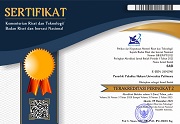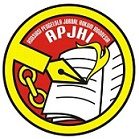PERATURAN MAHKAMAH AGUNG DAN PERATURAN MAHKAMAH KONSTITUSI MENURUT JENIS PERATURAN PERUNDANG-UNDANGAN DI INDONESIA
 )
)
(1) Fakultas Hukum Universitas Pattimura, Indonesia
 Corresponding Author
Corresponding Author
Abstract
The division of state power is divided into legislative power, executive power and judicial power. The task of government in carrying out public welfare within the meaning of the Constitution of the Republic of Indonesia Year 1945, in the implementation of needed legislation. Legislation in Indonesia is regulated in Law Number 12 Year 2011, the criteria used for such a legal instrument called a regulation regulations are written rules that contain legal norms binding in general and formed or defined by state agencies or officials authorized through the procedures laid down in Regulation Legislation. In Article 8 paragraph (2) one of the rules in the legislation recognized that Regulation of the Supreme Court and the Constitutional Court Regulation, then in this paper are analyzed on both the regulation which do not meet the criteria of legislation such as that contained in the Act No. 12 of 2011
Keywords
DOI
10.47268/sasi.v20i2.321
Published
2014-12-01
How To Cite
@article{SASI321,
author = {Vica Saija},
title = {PERATURAN MAHKAMAH AGUNG DAN PERATURAN MAHKAMAH KONSTITUSI MENURUT JENIS PERATURAN PERUNDANG-UNDANGAN DI INDONESIA},
journal = {SASI},
volume = {20},
number = {2},
year = {2014},
keywords = {Supreme Court; the Constitutional Court; Regulation},
abstract = {The division of state power is divided into legislative power, executive power and judicial power. The task of government in carrying out public welfare within the meaning of the Constitution of the Republic of Indonesia Year 1945, in the implementation of needed legislation. Legislation in Indonesia is regulated in Law Number 12 Year 2011, the criteria used for such a legal instrument called a regulation regulations are written rules that contain legal norms binding in general and formed or defined by state agencies or officials authorized through the procedures laid down in Regulation Legislation. In Article 8 paragraph (2) one of the rules in the legislation recognized that Regulation of the Supreme Court and the Constitutional Court Regulation, then in this paper are analyzed on both the regulation which do not meet the criteria of legislation such as that contained in the Act No. 12 of 2011 },
issn = {2614-2961}, pages = {1--13} doi = {10.47268/sasi.v20i2.321},
url = {https://fhukum.unpatti.ac.id/jurnal/sasi/article/view/321}
}
Asshiddiqqie Jimly, 2006, Pengantar Ilmu Hukum Tata Negara Jilid I, Sekretariat Jenderal dan Kepaniteraan Mahkamah
Konstitusi Republik Indonesia.
________________, 2006, Perihal Undang-Undang, Konstitusi Pers, Jakarta.
________________, Tata Urutan Perundang-Undangan Dalam Problem Peraturan Daerah, Jakarta, 2000.
Daulay Ikhsan Rosyada Parluhutan, 2006, Mahkamah Konstitusi, Rineka Cipta, Jakarta.
Hadjon Philipus M, 1992, Lembaga Tertinggi dan Lembaga Tinggi Negara Menurut Undang-Undang Dasar 1945, PT. Bina Ilmu, Surabaya
Soeprapto Maria Farida Indrati, 2007, Ilmu Perundang-Undangan Dasar-Dasar Dan Pembentukannya, Kanisius, Yogyakarta.
Soehino, 2007, Hukum Tata Negara Hukum Perundang-Undangan
(Perkembangan Peraturan Mengenai Tata Cara Pembentukan Perundang-Undangan, Baik Tingkat Pusat Maupun Daerah), BPFE-Yogyakarta, Yogyakarta.
Subekti R, 1992, Kekuasaan Mahkamah Agung R. I, Alumni, Bandung.
Syafie Inu Kencana, 1994, Ilmu Pemerintahan, CV Mandar Maju, Bandung.
Undang-Undang Dasar Negara Republik Indonesia Tahun 1945
Undang-Undang Nomor 5 Tahun 2004 Tentang Perubahan Atas Undang-Undang Nomor 14 Tahun 1985 Tentang Mahkamah Agung.
Undang-Undang Nomor 14 tahun 1985 Tentang Mahkamah Agung.
Undang-Undang Nomor 24 tahun 2003 Tentang Mahkamah Konstitusi.
Undang-Undang Nomor 12 Tahun 2011 Tentang Pembentukan Peraturan Perundang-Undangan.
| Dublin Core | PKP Metadata Items | Metadata for this Document | |
| 1. | Title | Title of document | PERATURAN MAHKAMAH AGUNG DAN PERATURAN MAHKAMAH KONSTITUSI MENURUT JENIS PERATURAN PERUNDANG-UNDANGAN DI INDONESIA |
| 2. | Creator | Author's name, affiliation, country | Vica J. E. Saija; Fakultas Hukum Universitas Pattimura; Indonesia |
| 3. | Subject | Discipline(s) | |
| 3. | Subject | Keyword(s) | Supreme Court; the Constitutional Court; Regulation |
| 4. | Description | Abstract | The division of state power is divided into legislative power, executive power and judicial power. The task of government in carrying out public welfare within the meaning of the Constitution of the Republic of Indonesia Year 1945, in the implementation of needed legislation. Legislation in Indonesia is regulated in Law Number 12 Year 2011, the criteria used for such a legal instrument called a regulation regulations are written rules that contain legal norms binding in general and formed or defined by state agencies or officials authorized through the procedures laid down in Regulation Legislation. In Article 8 paragraph (2) one of the rules in the legislation recognized that Regulation of the Supreme Court and the Constitutional Court Regulation, then in this paper are analyzed on both the regulation which do not meet the criteria of legislation such as that contained in the Act No. 12 of 2011 |
| 5. | Publisher | Organizing agency, location | Faculty of Law, Universitas Pattimura |
| 6. | Contributor | Sponsor(s) | |
| 7. | Date | (YYYY-MM-DD) | 2014-12-01 |
| 8. | Type | Status & genre | Peer-reviewed Article |
| 8. | Type | Type | |
| 9. | Format | File format | |
| 10. | Identifier | Uniform Resource Identifier | https://fhukum.unpatti.ac.id/jurnal/sasi/article/view/321 |
| 10. | Identifier | Digital Object Identifier | 10.47268/sasi.v20i2.321 |
| 11. | Source | Title; vol., no. (year) | SASI; Vol 20, No 2 (2014): Volume 20 Nomor 2, Juli - Desember 2014 |
| 12. | Language | English=en | en |
| 13. | Relation | Supp. Files | |
| 14. | Coverage | Geo-spatial location, chronological period, research sample (gender, age, etc.) | |
| 15. | Rights | Copyright and permissions | Copyright: Authors who publish their manuscripts in this Journal agree to the following conditions: 1. The copyright in each article belongs to the author, as well as the right to patent. 2. Authors can enter into separate, additional contractual arrangements for the non-exclusive distribution of the journal's published version of the work (e.g., post it to an institutional repository or publish it in a book), with an acknowledgment of its initial publication in this journal. 3. Authors are permitted and encouraged to post their work online (e.g., in institutional repositories or on their website) before and during the submission process, as it can lead to productive exchanges, as well as earlier and greater citation of published work. 4. Authors have the right to self-archiving of the article (Author Self-Archiving Policy)
License: The SASI Journal is disseminated based on the Creative Commons Attribution-NonCommercial 4.0 International license terms. This license allows anyone to copy and redistribute this material in any form or format, compose, modify, and make derivatives of this material for any purpose. You cannot use this material for commercial purposes. You must specify an appropriate name, include a link to the license, and certify that any changes have been made. You can do this in a way that is appropriate but does not imply that the licensor supports you or your use.
|
Copyright (c) 2020 Vica J. E. Saija

This work is licensed under a Creative Commons Attribution-NonCommercial 4.0 International License.

 : 2901 times
: 2901 times Download : 11929 times
Download : 11929 times
















